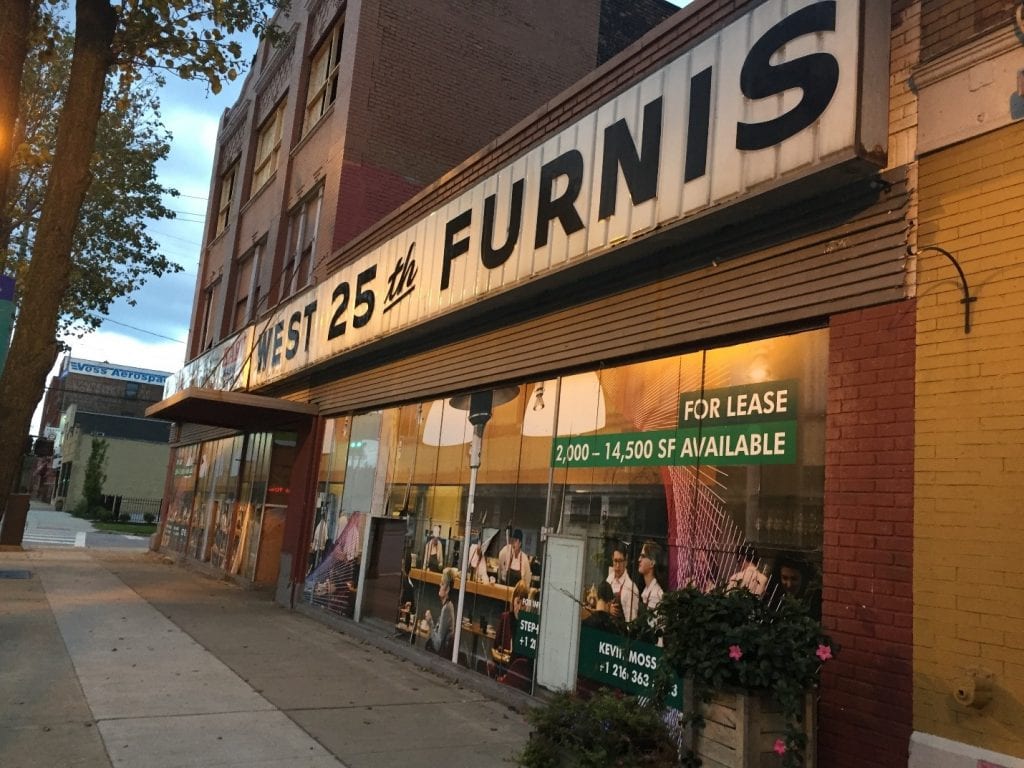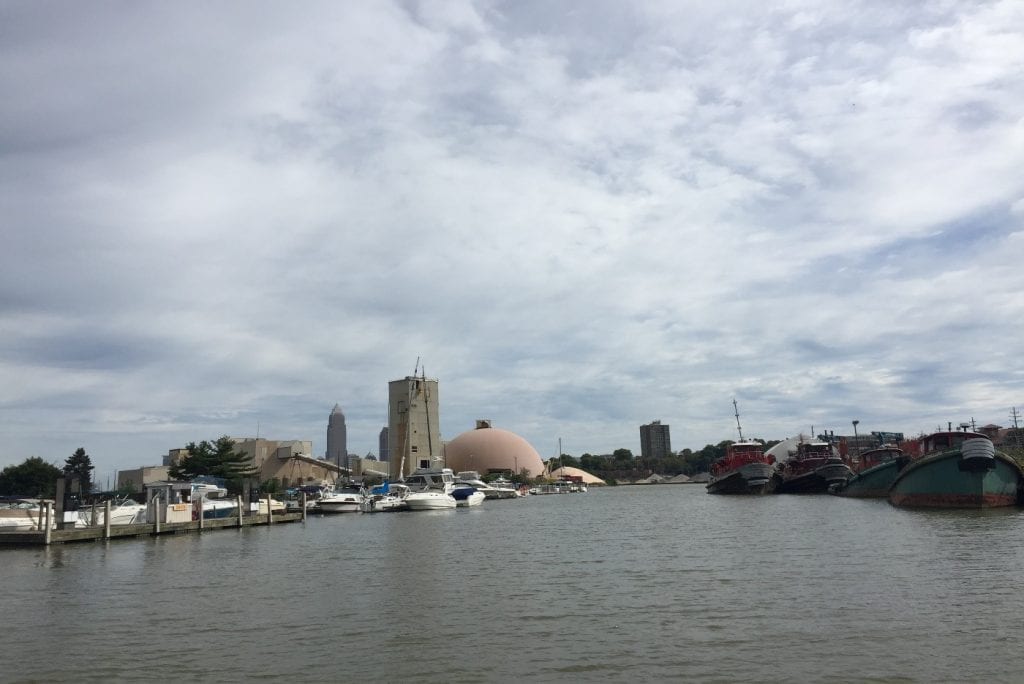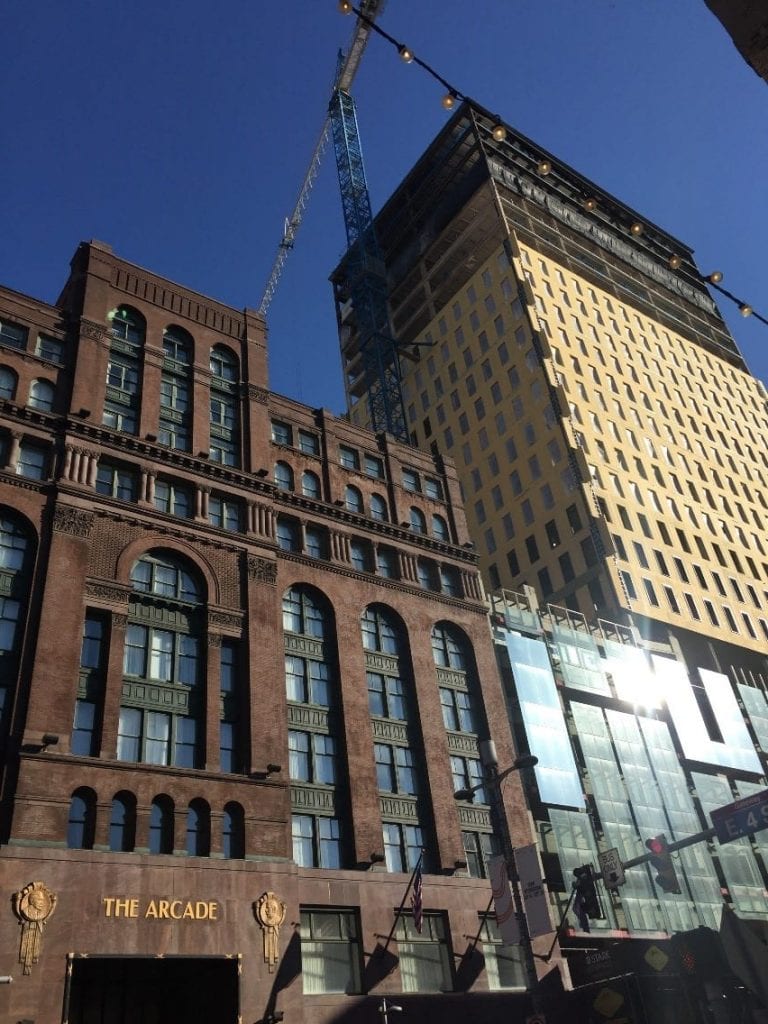
I began the Cleveland field trip with a curiosity to see what a Rust Belt city looks like given its industrial past, and left with questions about the role of historic preservation in both the built environment and the social life of an urban place. The trip introduced me to an industrial landscape which I had never seen so closely before: The boat ride along the river was especially eye-opening, as I was able to experience the “industrial city” with all senses–the smell of the fumes, the color of the water, the sound of the river traffic. So much of Cleveland’s industrial past lives on today, and at the same time so much has changed.
Figure 1 shows the dynamics between past and present, urban and industrial in Cleveland. On one hand, there are ships used for industrial purposes, there are historical bridges, and a salt plant of great size. On the other, there are the yachts that perhaps belong to an upper class who use the river for pleasure, the big-block, high-rise public housing, as well as the skyline in the background.

This picture describes my confused first impression of Cleveland. Everything on the urban landscape seems fragmented and spread out; a neighborhood somehow did not have the feel of a neighborhood. As we drove through Slavic Village, a disinvested area on the West Side, I could see little connection between the first few blocks of the residential area we saw when leaving the river port and the site where [Slavic Village’s] Third Federal Bank is located adjacent to a strip mall. However, it makes more sense when Cleveland’s history—its industrial peak and decline, housing crisis, and racial segregation—is considered. As we learned about the work of various agencies within the city, I developed a better understanding of how this landscape came to be.
Here’s a question that stuck with me through our three-day Cleveland journey: How should cities approach historic preservation? In particular, I was extremely interested in the preservationist approach to downtown Cleveland as we walked through the beautiful arcades, banks, and streets born in previous decades. The human effort and financial resources that goes into preservation of the past really impressed me. Entering the magnificent arcades made me feel as though time stood still inside these buildings, as though this part of Cleveland remained in place as the world moved on.

At the same time, I was struck by how empty, how lifeless the streets felt here. As we walked from 9 a.m. until noon, I counted only a few people walking the streets. As the tour guide said, the hotels are doing well but the stores are not, suggesting again that local people do not frequent these spaces. If there’s so much investment downtown, why are the streets so empty? How does historic preservation contribute (or not) to this lack of public life that I saw and experienced? Is it because the monumental, ornamented architecture of the past lacks the human scale often seen in other more vibrant downtowns, and the stores are inside, instead lining the sidewalks? If so, to what extent should we preserve historic structures? To what extent should we reconstruct and bring back the past? Where is the balance between historic preservation and contemporary development, and how does it impact the urban landscape and life?
As we approached downtown’s Erieview area and the Mall, new developments take over. Urban renewal in Cleveland as well as in many other places tore down existing communities without resources for replacement. As a result, these areas became placeholders for today’s development. As we walked Superior Avenue, instead of the historic arcades, I saw a much more modern landscape, with taller buildings and wider streets. Not much of the past remains. Again, there were not many people on the streets, perhaps besides one person sleeping on the corner. As we were crossing the street, a policeman approached the man and asked him to move. Again, the experience in downtown Cleveland really made me ask–in between the development of today and preservation of the past, who is the city built for?
My last picture raises questions and perhaps hope about the future of Cleveland. Right next to our hostel is an abandoned building labelled West 25th Furnis (pictured at top). A quick Google search tells me that it was once a grocery store that complemented the adjacent West Side Market. The building then housed a furniture store, and it is now vacant. The value of the prime location at the corner of two streets, however, has not been forgotten. On both sides of the building there are murals that speak to the spirit of the city, which attract tourists and locals alike to come and take pictures. What is usually not captured in their photos, though, is the dilapidated structure above it, a place where locals once came to do their grocery or furniture shopping. Can Cleveland move forward by putting the past in the background and foreground new developments through its tax abatement program? What will be the next use of the building? What future awaits Cleveland?
Minh Tran, MRP 2020